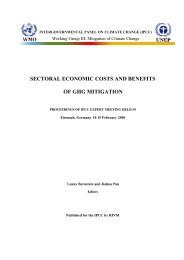Pacific Islands Environment Outlook - UNEP
Pacific Islands Environment Outlook - UNEP
Pacific Islands Environment Outlook - UNEP
You also want an ePaper? Increase the reach of your titles
YUMPU automatically turns print PDFs into web optimized ePapers that Google loves.
26<br />
STATE OF THE ENVIRONMENT<br />
Table 1.6: Contamination by persistent organic pollutants in PICs<br />
(not including PNG or French and US territories)<br />
Category<br />
Agricultural chemicals (including DDT)<br />
Potentially PCB contaminated transformer oil<br />
Estimated quantity<br />
130 tonnes<br />
220 000 litres<br />
Pesticides contaminated sites 21<br />
Bitumen contaminated sites 8<br />
Oil and diesel contaminated sites 29<br />
CCA contaminated sites 7<br />
Potentially contaminated solid waste disposal sites 20<br />
Source: SPREP/AusAID (1999)<br />
disposal in another country and the means to ensure<br />
adequate chemicals management in the future, in<br />
particular for school laboratory and medical chemicals<br />
The three Rs of waste management – reduce, reuse<br />
and recycle – cannot be fully applied in the<br />
circumstances of most PICs. The size of the market is<br />
too small to impose special packaging requirements, and<br />
this also affects the economic opportunities for<br />
recovering waste materials or recycling them.<br />
give effect to the Waigani Convention and the Global<br />
Programme of Action for the Protection of the Marine<br />
<strong>Environment</strong> from Land Based Activities.<br />
Conclusions<br />
All PICs share the problems of waste disposal and the<br />
prevention of pollution. The small size, remoteness,<br />
physical structure and rapid urbanization of many<br />
islands have exacerbated these problems.<br />
Overcrowding has serious consequences for<br />
environmental contamination, not only from sewage, but<br />
also from the disposal of animal waste (especially from<br />
pigs) and household garbage, and because of the limited<br />
supply of fresh water. There are very limited recycling<br />
and waste management programmes in the small<br />
countries, and rubbish is generally burned or dumped<br />
into the sea or in mangroves.<br />
Incidents of dangerous and illegal pollutants being<br />
discharged into streams and oceans have increased, hand<br />
in hand with a growing manufacturing industry. Point<br />
source pollution from industrial wastes and sewage,<br />
inappropriately sited and poorly managed garbage dumps,<br />
and disposal of toxic chemicals are all significant<br />
contributors to marine pollution and coastal degradation.<br />
Changing patterns of consumption in the next few<br />
decades as countries’ GDP and the population’s affluence<br />
increases are likely to be reflected in major rises in per<br />
capita waste generation. Increased use of plastics, paper<br />
and metal (cans) through importation by the packaging<br />
industry is indicated. Consequently, non-organic waste<br />
management is expected to become an increasingly<br />
critical environmental challenge throughout the region,<br />
surpassing that of disposal of organic waste.<br />
Contamination from stockpiles and past disposal of<br />
persistent organic pollutants presents a challenge for<br />
PICs. The challenge will include rehabilitation of sites,

















